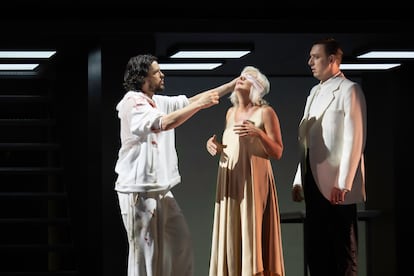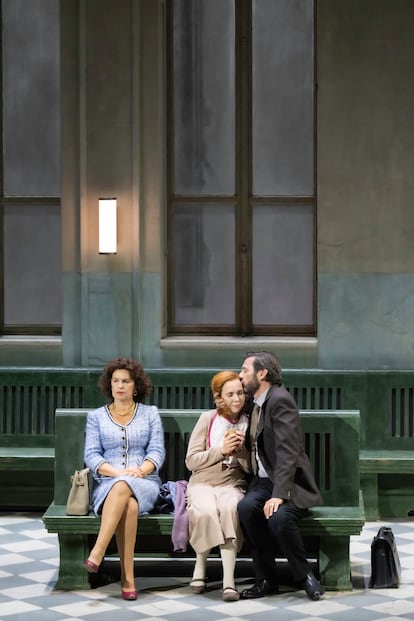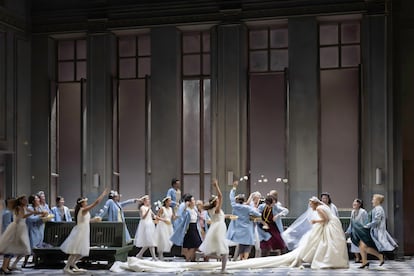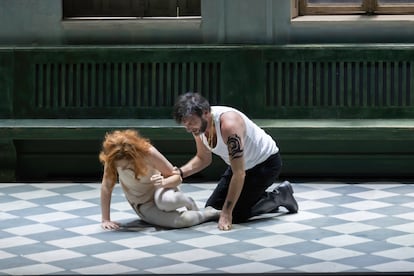The Aix-en-Provence Festival celebrates Mozart and mourns its conductor Pierre Audi

The prelude could not have been more difficult. On May 3rd, in Beijing, Pierre Audi, general director of the Aix-en-Provence Festival since 2018, died suddenly. Audi remains shaken and orphaned to this day, to the point of having asked his predecessor, Bernard Foccroulle, to be the "advisor" in charge of bringing this edition to a successful conclusion, entirely designed by the Franco-Lebanese director, who died just two weeks before rehearsals for the five new productions, including a world premiere, were to begin. A two-day strike by French air traffic controllers (a déjà vu that systematically sows chaos in air traffic in southern Europe and the resulting despair among travelers) led to the cancellation of hundreds of flights on Thursday and Friday, making arriving on time for the opening of the festival in the Provençal city little less than an impossible mission for many foreign spectators.
The Grand Théâtre de Provence, built on gently sloping terrain, borders the so-called Avenue Wolfgang Amadéus Mozart at its top. The name chosen is no coincidence, as the festival has a long history of Mozart performances, some more successful than others: among the most recent, at both extremes, the extraordinary production of The Magic Flute. Conceived by Simon McBurney and the gruesome reimagining of Così fan tutte perpetrated by Dmitri Tcherniakov. It was somewhat, or quite a lot, a fatal coincidence that the Don Giovanni that opened the festival on Friday, before the opening, opened with an apparent heart attack by the Commendatore just two months after a heart attack had ended Audi's life in Beijing. Fallen on the ground, much later we find Don Giovanni in an identical position, with the same curtain covering his body, although it will take us a long time to understand that the dissolute punito is, in fact, the Commendatore himself as a young man. In the aria from Leporello's catalogue, when he sings " la piccina è ognor vezzosa ," a little girl appears wearing high heels and carrying a teddy bear. The little girl reappears numerous times as unequivocal confirmation that she is, in turn, Donna Anna, a victim of sexual abuse by her father. But, until we get there, the confusion, increased by the projection of repetitive and disruptive videos, is enormous.

The main problem with playwright and theatre director Robert Icke's proposal—in his first operatic production—is that it seems designed more to satisfy him than the audience, who are often lost in the strange twists and turns his production traverses, largely conceived with the back of, or even without, music. Convoluted and extremely slow recitatives, with hardly any harmonic support and the only instrumental support of a harpsichord, clash sharply with the lively tempos , right from the opening, of Simon Rattle, who makes great use of his Bavarian Radio Symphony Orchestra (making its debut in Aix), although the British composer has always shown himself to be decidedly more akin to Haydn than to Mozart.
Among his singers, there's a bit of everything. The British actor's wife, Magdalena Kožená, no longer has the talent to do justice to the merciless writing of Donna Elvira, which causes him no small amount of disappointment. Golda Schultz is much more suitable to portray Donna Anna, although her singing is hampered by very poor Italian diction and her stage presence by very limited acting skills; in the concertos, however, she is always an infallible mainstay. Andrè Schuen seems like a natural Don Giovanni, but Icke makes sure to litter his path with obstacles and tricks, to the point of even needing a double to violently fall down a staircase in the final scene.
The two Polish baritones, Krzysztof Bączyk (Leporello) and Paweł Horodyski (Masetto), are superb, better singers than actors. Madison Nonoa's Zerlina is barely audible, and Amitai Pati's Don Ottavio is equally puny and uncertain: all four, within this highly multiracial cast, are former students of the Festival Academy. Clive Bayley lacks vocal strength to embody the Commendatore and frequently appears on stage after his undeath. Icke forces the orchestra into a very long tacet in the three operatic quotations (the third a self-quotation from his Le nozze di Figaro ) that precede the final scene, which are recorded from the record player the Commendatore operates at the top of a blackish, drab, and somewhat ugly set.
In the program, Timothée Picard, playwright of the Aix-en-Provence Festival, reviews notable and influential artistic, literary, and theatrical incarnations of the Don Juan myth: everything suggests that this production of Mozart's Don Giovanni (the eighth presented by the Provençal festival in its 77 editions) does not possess enough merit to be even remotely included in the list. It was received with indifference, laconic and almost symbolic applause (it is not easy for the local audience to accept the failure of the opening day of a major festival) and resounding boos for the stage crew.
Quite the opposite happened on Saturday afternoon at the Théâtre du Jeu de Paume, where an original experiment was presented: the reduction of Benjamin Britten's Billy Budd to a sort of chamber opera, shortened by a quarter of its length, with a handful of singers and just four instrumentalists, all of them permanently on the small stage of the theater on the Rue de l'Opéra. Oliver Leith was responsible for the instrumental conversion, which goes far beyond a simple pianistic reduction. The use of two electronic keyboards, a baby grand piano, and a small number of percussion instruments (glockenspiel, tubular bells, rototoms, timpani, kalimba, cortinilla, thunder plate, sierra, cuica, bass drum, and whistle) ensures timbral diversity, and, accustomed to these new guises, the original orchestration is never missed.
One of its performers, Finnegan Downie Dear, acts as an effective keyboard arranger, as well as playing Red Whiskers, one of the sailors forced onto the Indomitable , the warship on which the action takes place. Siwan Rhys (who plays the only piano and is the only woman) also briefly plays the Boy in the second act, and Downie Dear and Richard Gowers join her to play six-handed piano for several bars during Billy's moving final farewell.
The singers also double roles, and Joshua Bloom, for example, is both the evil John Claggart and the kind-hearted Dansker, an old sailor who is a confidant of Billy Budd. Christopher Sokolowsi, in addition to Captain Vere (the third vertex of the protagonist's triangle), is also Squeak, one of the two sailors used by Claggart to frame Billy. The stage is limited to a small white platform, the same color as the shirts and trousers worn by both singers and instrumentalists. On either side are small pieces of equipment (a table, a pair of chairs) and elements that allow them to change their appearance when they need to change characters (an orange cap for Dansker, one of the few hints of color, false beards and mustaches, and jackets for the officers' uniforms). In the background, a ship's sail is seen hoisted and furled.
Every movement, both on and off the stage, is perfectly studied and executed, giving the drama a kind of inevitability. And the closeness to the audience exponentially increases the intensity of what we are told in Herman Melville's "inner narrative": the "natural depravity" of John Claggart, the "man of sorrows" (" man of sorrows " - a quote from the Book of Isaiah ) or, in a biblical expression borrowed by the American writer from Saint Paul, the "mystery of iniquity." And with the great moral dilemma of whether an innocent being should be punished hovering over the entire final stretch of the opera.
The New York director, Ted Huffman, just barely underplays the homoerotic atmosphere of the opera, only daring to express the attraction between the two younger characters, Billy and the novice, on two occasions, embodied in kisses. Otherwise, his objective, unlike Robert Icke's, is to present Melville's story with the constant complicity of the music. None of the cuts, even for opera connoisseurs, ooze too much, although the famous sequence of 34 chords that sound while Vere delivers Billy's sentence could have been kept complete; here, it's reduced to just 19, with the captain standing alone on stage, his back to the audience.
The attack on the French ship, the fog at the beginning of the second act, the final threat of mutiny (with music borrowed from the first act) or the realistic execution of Billy, exemplarily embodied by the American baritone Ian Rucker: everything is captured clearly and sensitively thanks to the absolute complicity and involvement of a group of perfectly chosen singers, young and convinced of the goodness of the transformation they were carrying out in collusion with the four instrumentalists. At the end, after Vere’s epilogue – a mirror image of the prologue, in which Britten showed his enduring and symbolic bond with the young sailor by making his own some of the music he had just sung in his final performance after blessing and thus forgiving him – the audience spontaneously erupted into applause and cheers: not only had the experiment worked, with Huffman and Leith adding their names to the extraordinary creation by Britten and Eric Crozier and E.M. Forster, its two librettists, but it had also left a deep and, no doubt, lasting impression on all the spectators.

In a letter he wrote to his friend Claude Debussy on February 1, 1900, after attending the dress rehearsal prior to the premiere of Louise , Gustave Charpentier's first opera, the writer Pierre Louÿs bids an ironic farewell, thanking his friend for having been kind enough "not to have written the score I have just heard." The author of the Chansons de Bilitis , who had also been present at the rehearsal, also took issue with the derogatory epithets in a reply letter dated five days later: "vulgar beauty," "imbecile art," "chlorotic canticles," "parasitic harmonies." The description of Parisian “life” in Louise is similar to the “sentimentality of a gentleman returning home at four in the morning and bursting into tears at the sight of street sweepers and rag-pickers: and this man thinks he can search the souls of the poor!!! He’s so stupid it’s touching.” And he adds a lapidary phrase: “Many more works like Louise and there’ll be no hope of getting them out of the mud,” referring to the early flatterers of opera. It is worth noting that, two years after the premiere of Charpentier’s work, and in the same theater (the Opéra Comique), Debussy premiered Pelléas et Mélisande , which abruptly changed the course of the genre thanks to the evanescent symbolism of Maeterlinck’s drama. And in Aix-en-Provence, Katie Mitchell's superb production was recently seen twice, in 2016 and last year .
The truth is that Louise was a colossal success upon its premiere, almost a sociological phenomenon rather than a musical one, and half a century later, it had racked up more than a thousand performances, with the long-lived Gustave Charpentier still celebrating it with his fellow citizens in 1950. Its Zola -esque naturalism, its consideration of Paris in general, and Montmartre in particular, as a central theme in the work, its choice of humble characters from modest social backgrounds, also caused a furor among the working classes (something similar happened, incidentally, after the premiere of Peter Grimes in London), normally disassociated from a genre almost always associated with heroes, gods, or aristocrats. But what happens when Louise is presented in a single interior setting, almost completely devoid of that realism, turning what Charpentier called a "musical novel" into a—thus renamed by Loy—"psychological musical novel"?

The answer emerged well past midnight on Saturday into Sunday at the Thèatre de l'Archevêché. Had it been seen like this in 1900, without the sewing workshop, without the modest garret of the protagonist family, without the street splendor of the party in the third act, without any glimpse of the Butte Montmartre, without the picturesqueness of its humblest people, it might not have lasted more than a dozen performances. But the tables have turned, and now we would find it hard to swallow that papier-mâché naturalism. Christof Loy has attempted to understand that overwhelming success and, in doing so, forces us to look from another perspective, surprisingly similar in its Gordian knot to the one adopted by Robert Icke in Don Giovanni , but with infinitely superior results, because, unlike the Englishman, the German did think of the audience and did act according to the music, however poor its quality almost always is. From the outset, we're left wondering what this unique space represents, resembling a vast waiting room with a long bench. We're also unsure of what's hidden behind a door through which patients enter, and from which male and female nurses occasionally emerge. Another mother, accompanied by her daughter, gives us the first clue.
It is quite clear that Louise, the protagonist, who exhibits multiple bodily tics, has an ailment that requires treatment and healing, but the pieces don't begin to fall into place until the end. The first clue is the transformation of Louise's father, who goes from being the loving and possessive parent of the first act to a shady character, who displays a huge tattoo on one arm and now wears high boots very similar to Julien's, thus dangerously resembling and intertwining father and lover. Little by little, we understand that Louise's father is much more dangerous than the brutal mother of the first and second acts, because the waiting room is, after all, a clinic, perhaps clandestine, where abortions are performed. Louise, who in the final duet with her father pushes his hand away when it approached her private parts with impunity, is pregnant as a result of the sexual abuse she suffered in her own home (and here the similarities with the Don Giovanni of the previous day explode with force and greater visibility) and, at the end of the fourth act, instead of freeing herself from what Loy defines as a “toxic relationship” with her parents, who refuse to let her fly and accept her choice of partner, she leaves the clinic with her mother – complicit or not in her husband's excesses – wearing the same nun's dress as at the beginning, after having worn the white wedding dress in the second act and the red party dress in the third, as submissive as before and, most likely, with an added and incurable psychological defect. Loy doesn't need to resort to girls or videos to put his puzzle together: the pieces fall into place on their own, as always in German, based on small, often almost imperceptible details.

Elsa Dreisig, malleable as Play-Doh, bends docilely and efficiently to his wishes, creating a very complex character with great acting demands, much better calibrated than those of Robert Icke for Andrè Schuen. Half-French (she is the daughter of Gilles Ramade) and a perfectionist by nature, she performed everything well, although curiously she didn't offer her best performance in her aria at the beginning of the third act, "Depuis le jour," the only surviving version of a rightly forgotten opera, which she has sung in concert and which she knows perfectly. Perhaps due to tiredness, perhaps because he arrived just after the interval, perhaps due to pressure, he did not reach his usual level here, which is, for example, that of his recent Sifare in this season's Mitridate at the Teatro Real (Claus Guth is also in Aix-en-Provence these days) or that of his unforgettable Così fan tutte in Salzburg in 2020 (directed by Loy himself, and with Andrè Schuen as Guglielmo).
Opposite his subtlety are Adam Smith's coarse singing and stiff, self-sufficient performance as Julien, which has made as poor an impression this time as it did in his Pinkerton in Madama Butterfly last year on the same stage (then alongside Ermonela Jaho: his great female colleagues also fail to inspire him). Nor is bass Nicolas Courjal a paragon of naturalness as Louise's father, an unrefined singer with a highly discontinuous line. Sophie Koch, as the vampire mother, displays better manners, although far from her brilliance, in what was her stage debut in Aix. Loy moves her characters with mastery, bordering on virtuosity in the collective performances, especially the one in the sewing workshop in the second act and the festive celebration in the third. It's a shame that the veteran Roberta Alexander was dropped from the role of the street sweeper, and the superb Spanish singer Carol García was also dropped from the role of Gertrude. The applause was more generous than for Don Giovanni , but it carried with it a kind of resignation, realizing that Louise hasn't been capriciously forgotten. Even so, it's highly recommended to see this highly intelligent production, which will be available starting July 12 on the Franco-German radio station ARTE . The most humble, the most experimental, the most daring, the Billy Budd heard just hours earlier at the Jeu de Paume on Saturday afternoon, has by far left and—hopefully—will continue to leave a lasting mark on the opening of the Aix-en-Provence Festival, this year with black crepe fabric.
EL PAÍS



